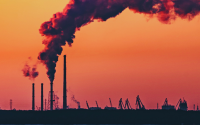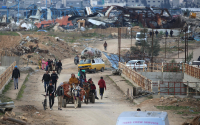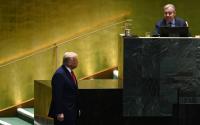12 September 2006Monbiot.com / The Guardian
It is as far out of sight, and as far out of mind, as any place on the British mainland could be. From the point of view of our political leaders, this is just as well. If the perennial farce at the Dounreay nuclear site, on the north coast of Scotland, were any closer to the surface of public consciousness, we would be hounding and haranguing them wherever they go. A report in this week’s Sunday Times suggests that the agencies charged with cleaning the site up have, in effect, conceded defeat(1). Dounreay – or the area surrounding it – cannot be wholly decontaminated. Nuclear pollution from the site will last for as long as the fissile metals remain radioactive.
Perhaps we should not be surprised to discover that when the experimental reactor at Dounreay was commissioned, no thought was given to the problem of how it might be dismantled. In 1954 the nuclear industry, shielded from public scrutiny by the official secrets act, behaved as if it were based on an uninhabited planet. The cold war and the prospect of electricity too cheap to meter seemed to justify almost any kind of corner-cutting.
Nor, sadly, is there anything unusual about the plant’s later cock-ups. Last month, for example, Dounreay was fined £2 million for spilling radioactive waste(2). Last year, its regulators reported that 250 safety failures had taken place since 1999(3). Among them was Dounreay’s generous gift to the community of containers used to store low-level radioactive waste. They were to be turned into a Santa’s grotto for local children(4). Another report showed that fissile waste was being stored in paint tins or simply left where it had been found(5). One former employee claimed that samples from Dounreay’s radioactive effluent tanks were collected for analysis with a wellington boot on a piece of string, as the proper equipment had rusted up(6).
Incidents of this kind have taken place at several nuclear sites around the UK. But there are two special features at Dounreay which distinguish the running of this plant from the ordinary catalogue of hazards.
Before the reactor at Dounreay was completed, the operators – the UK Atomic Energy Authority (UKAEA) – bored a tunnel under the sea bed, through which its liquid effluent would be discharged. In order to remove the spoil, UKAEA dug a 200-foot shaft a few yards behind the cliffs. Though this hole was unsealed, though groundwater could flow in and out and though coastal erosion could pull the whole thing down into the sea within 100 years(7), in 1959 the British government gave UKAEA permission to use this shaft as a dump for radioactive materials.
In 1977, the shaft exploded, blowing the lid off and scattering hot particles. It would not be strictly true to say that the incident was covered up. After rumours of the accident reached the press, UKAEA issued a news release entitled “minor incident at solid waste facility”(8). The word “explosion” was not mentioned.
The full story did not emerge until 1995. The hole had been used to dispose of everything from rubber gloves to fissile waste. It is not hard to see why this dirty bomb went off: sodium and other reactive chemicals had been dumped with the radioactive materials. One estimate suggests that around 2.2kg of plutonium and 81kg of uranium-235 ended up there(9). But the auditing was patchy: some of the disposals were never recorded; some of the records later disappeared. In 1998, the Guardian discovered that a second hole had been dug, and was still in use despite the demands by government inspectors that it be closed(10). This one was slightly safer, as it was lined with concrete. But it contained a similar mixture of fissile materials and reactive chemicals, which had not been kept apart. Underground fires had already broken out(11).
Though it has been out of use since the explosion in 1977, UKAEA began sealing off the first hole from the groundwater only last week(12). It must now build robots which can start removing the contents. Isolating and clearing it will cost at least pounds 180 million, and take until 2025 to complete(13). But this is the least of Dounreay’s problems.
I mentioned that the shaft was dug to build a tunnel taking nuclear effluent out to sea. In theory, only the liquids drained off the top of Dounreay’s settling tanks would flow down this tunnel. But the waste did not settle properly(14). As well as the liquid, perhaps hundreds of thousands of pieces of fuel rod were also washed out. There is now a plume of radioactive particles on the seabed to the north of Dounreay covering hundreds of square kilometres.
The public knew little of this until 1997, when two fragments of fissile material were found on Sandside Beach, 3km away. Sandside is visited by thousands of people every year. Sixty-eight particles have been detected there so far, but the man who owns it – Geoffrey Minter – claims that this represents a small fraction of the contamination, as UKAEA’s robots have been scanning the beach only once a month and only to a depth of around 10 centimetres(15).
In 2003 a Scottish Court found that UKAEA had failed in its duty of care to local people by releasing the particles into the environment(16). But Mr Minter alleges that even since that ruling its detection and removal of particles from the beach has been inadequate. Its sampling exercise, he claims, “has degenerated into a public relations stunt intended merely to give people the impression that the UKAEA was tackling the underlying hazard.”(17) UKAEA insists that it is complying with the Scottish Environment Protection Agency’s rules(18).
What can be done to prevent particles from washing up on the shore? The answer now appears to be nothing. The Dounreay Particles Advisory Group has just sent a report to the environment agency suggesting, according to the Sunday Times, that the best way of removing the particles from the seabed is by sending down divers(19). This is a counsel of despair. Of the hundreds of thousands of particles believed to be sitting on or in the seabed, UKAEA’s divers have managed to remove only 900 since 1983(20). Complete decontamination using dredgers, UKAEA claims, would cost some £70 billion(21), which is another way of saying it can’t be done.
So what should we conclude from this story? The catalogue of idiocy at Dounreay is not necessarily an indictment of all nuclear installations: nuclear power stations built today couldn’t get away with practices like this. But it shows that when things go wrong they can be incredibly hard to redress. Dounreay’s story also reflects the fact that corner-cutting is a constant temptation, as disposing of waste properly is difficult and expensive.
It also provides a powerful argument in favour of the precautionary principle. This is the much-maligned idea that those intending to do something potentially hazardous should first demonstrate that it will not present a significant risk to the public. But perhaps above all it is another argument for open government. None of this could have taken place if Dounreay’s operations had been open to public scrutiny. The disasters there happened for the same reason as the disasters in Iraq: the government used “security” as its excuse for hiding the truth from the public.
George Monbiot’s book Heat: how to stop the planet burning is published this month by Penguin.
UPDATE: On the day this article was published, a friend of mine got in touch with another story about Dounreay. In 1959, the liquid sodium in the fast reactor’s cooling system kept oxidising. At first this presented a mystery to the operators. Eventually it transpired that one of the workmen had dropped his sandwiches into the reactor.
References:
1. Mark Macaskill, 10th September 2006. Divers risk death to clear atomic beach. The Sunday Times.
2. Mark Milner, 11th August 2006. Nuclear operators fined £2m each for radioactive spillages. The Guardian.
3. Rob Edwards, 15 May 2005. Revealed: the safety ‘failures’ at Dounreay. The Sunday Herald.
4. ibid.
5. David Ross, 16th June 1998. Dounreay damned in report of defects. The Herald.
6. Kenny Farquharson and Mark Macaskill, 6th March 2005. ‘Reckless’ nuclear plant dumps waste on beaches. The Sunday Times.
7. See Friends of the Earth Scotland, 6th October 2000. Dounreay: Half-Lives, Half Truths. http://www.foe-scotland.org.uk/nation/dounreay.html
8. UKAEA, 10th May 1977. Minor Incident at Solid Waste Facility – Dounreay. Telex.
9. The National Radiological Protection Board, cited by David Ross, 22nd May 1997. Dounreay Admits Shaft Error. The Herald.
10. John Arlidge, 2nd February 1998. Fresh scare on nuclear waste. The Guardian.
11. ibid.
12. Colin Punler, UKAEA press officer, pers comm.
13. John Ross, 15th June 2006. Decades-long task of taking apart Dounreay. The Scotsman.
14. Colin Punler, UKAEA press officer, pers comm.
15. Sandside Estate, 6th September 2006. Press and Journal article 6.9.06. Press release.
http://www.sandsideestate.com/pressRelease.asp?releaseId=526
Sandside Estate, 24th March 2006. Dr Day stands by…... Press release. http://www.sandsideestate.com/pressRelease.asp?releaseId=495
16. Outer House, Court Of Session, 15th August 2003. Opinion Of Lady Paton
In The Petition Of Magnohard Limited And Others.
http://www.scotcourts.gov.uk/opinions/p777_02.html
17. Sandside Estate, 14th February 2006. Sandside Owner Expels Nuclear Chiefs From Contaminated Beach. Press release. http://www.sandsideestate.com/pressRelease.asp?releaseId=491
18. Colin Punler, UKAEA press officer, pers comm.
19. Mark Macaskill, ibid.
20. John Ross, 10th January 2006. Nuclear particles ‘to stay on beach and in sea for ever’.
http://news.scotsman.com/topics.cfm?tid=566&id=41692006
21. David Ross, 10th January 2006. Clean up the nuclear beach at Dounreay? £70bn please. The Herald.






